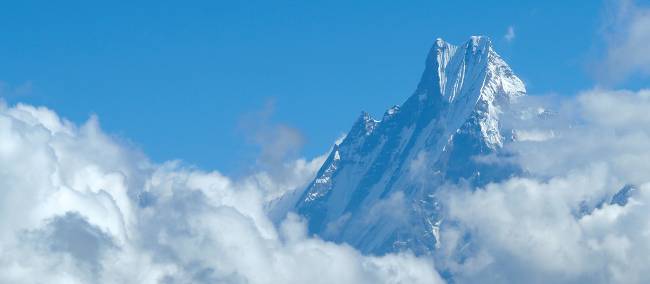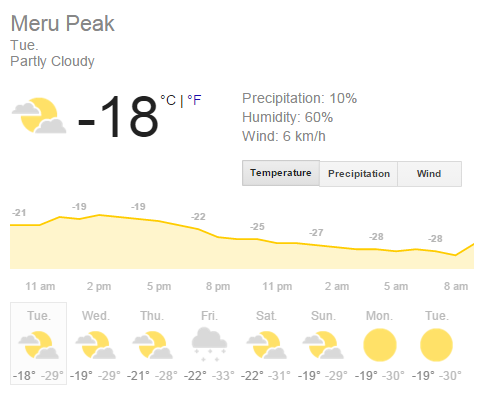
Machapuchare peaking through the clouds | Andrew Dixon / Bardo Imber-Dixon
Embarking upon a mountaineering expedition is serious business: you’re up against your physical limitations for dealing with the altitude, your mental and physical fitness are tested, not to mention the challenges of the terrain and importantly, the weather!
Every mountaineer should be able to read mountain weather and keep a close eye on what the weather is doing while climbing. At high altitude the frequent changes in the weather, however slight, can impact your climb and potentially the safety of you and your group. Taking elements such as wind, precipitation, snow and forecasted temperatures into consideration is mandatory when heading into the hills. If on a guided climb, your guides will be mitigating your chance of getting stuck in dangerous weather through their expertise and experience, however for those who want to learn a little more, here are our top tips for predicting mountain weather.
Note that the below steps for checking weather while on a mountaineering expedition may not apply equally for all types of trips. Shorter climbing trips, say based out of a mountain hut in New Zealand or chalet in the Alps, may allow for weather forecasting using guidance from online or radio-based resources, however longer expeditions in more remote destinations may limit you to weather forecasting techniques that primarily involve observing and interpreting the environment around you.
1. Check the weather forecast before heading out
Daily Forecasts:
 When internet resources are available, it's a good idea to check the local weather forecast before you head out to gain an insight into what precipitation and storm forecasts will be like on your climbing trip. Hint: Ensure that the forecast is for the actual location of your climb, not the nearest town or region. This is because if you are climbing at altitude, the nearest town could be thousands of feet lower than your climb, with significantly different weather than your climbing destination.
When internet resources are available, it's a good idea to check the local weather forecast before you head out to gain an insight into what precipitation and storm forecasts will be like on your climbing trip. Hint: Ensure that the forecast is for the actual location of your climb, not the nearest town or region. This is because if you are climbing at altitude, the nearest town could be thousands of feet lower than your climb, with significantly different weather than your climbing destination.
Hourly forecasts:
If possible, take a deeper look into your forecast by analysing the hourly weather pattern. You’ll be able to see estimated freezing altitude, wind speed and direction, precipitation and of course temperature fluctuations. Use this information as a guideline only, as mountain weather changes quickly and often with little warning. Hint: a day that starts with ideal conditions may not end up that way. You must be prepared for any weather every time you head out into the mountains.
2. Chat with the locals
The people who live in the region may have insights into how the weather turns in the region, and what to look out for at certain times of the day regarding weather patterns. This could include particular wind patterns to be made aware of, afternoon cloud build-up or other potential weather hazards higher on the mountain.
3. Keep an eye on the Sky and read mountain weather

This is the most important part of predicating mountain weather. Reading and interpreting the sky is an essential element of safe mountaineering. Keep an eye out if the weather appears to be moving in quicker than expected, and adjust your plans accordingly. Knowledge of mountain weather prediction comes with time and repeated exposure to the variety of prevailing weather systems.
Understand the differences in the Clouds
If you know what to look for with clouds, you can often predict whether a storm will occur and the intensity of the storm. Below are the most common clouds you may experience.
-
Lenticular clouds, otherwise known as a “Hogs-back” for its distinctive shape, often indicate a powerful system moving in. Combined with strengthening winds, this often means a storm will approach in the next 6-24 hours.
-
Cirrus clouds are high altitude, whispy clouds. When seen alone, they can be fine, however if combined with low clouds known as stratus clouds, it could be seen as a sign that rain is on the way.
-
Cumulous clouds are large, white and puffy clouds that can indicate fair weather.
-
However, if they get taller and have many heads, or bumps, they can bring heavy rain and eventually turn into cumulonimbus clouds, capable of bringing hail, strong wind, thunder and lightning.
Look out for other storm indicators
Keep an eye out for these other indicators which can show more unstable and difficult weather is just around the corner:
-
Dropping of air pressure: If you have a pocket barometer with you, note that a drop in air pressure can indicate a storm is approaching. However, a rise in altitude will also cause a drop in air pressure so take this into account when analysing the results.
-
Moderately bad weather at low altitudes almost always means worse conditions up high. If you are commencing a climb in rain and cloud, there is a high likelihood that conditions will be far more unpleasant the higher you go. This is not always the case, however. At times, a low altitude cloud system will give way to ideal conditions above the clouds. So the bottom line, hope for the best but be prepared for the worst!